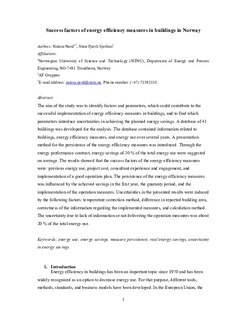| dc.contributor.author | Nord, Natasa | |
| dc.contributor.author | Sjøthun, SF | |
| dc.date.accessioned | 2019-01-21T12:58:57Z | |
| dc.date.available | 2019-01-21T12:58:57Z | |
| dc.date.created | 2014-08-27T13:00:41Z | |
| dc.date.issued | 2014 | |
| dc.identifier.citation | Energy and Buildings. 2014, 76 476-487. | nb_NO |
| dc.identifier.issn | 0378-7788 | |
| dc.identifier.uri | http://hdl.handle.net/11250/2581563 | |
| dc.description.abstract | The aim of the study was to identify factors and parameters, which could contribute to the successful implementation of energy efficiency measures in buildings, and to find which parameters introduce uncertainties in achieving the planned energy savings. A database of 41 buildings was developed for the analysis. The database contained information related to buildings, energy efficiency measures, and energy use over several years. A presentation method for the persistence of the energy efficiency measures was introduced. Through the energy performance contract, energy savings of 30% of the total energy use were suggested on average. The results showed that the success factors of the energy efficiency measures were: previous energy use, project cost, consultant experience and engagement, and implementation of a good operation plan. The persistence of the energy efficiency measures was influenced by the achieved savings in the first year, the guaranty period, and the implementation of the operation measures. Uncertainties in the presented results were induced by the following factors: temperature correction method, difference in reported building area, correctness of the information regarding the implemented measures, and calculation method. The uncertainty due to lack of information or not delivering the operation measures was about 20% of the total energy use. | nb_NO |
| dc.language.iso | eng | nb_NO |
| dc.publisher | Elsevier | nb_NO |
| dc.rights | Attribution-NonCommercial-NoDerivatives 4.0 Internasjonal | * |
| dc.rights.uri | http://creativecommons.org/licenses/by-nc-nd/4.0/deed.no | * |
| dc.title | Success factors of energy efficiency measures in buildings in Norway | nb_NO |
| dc.type | Journal article | nb_NO |
| dc.type | Peer reviewed | nb_NO |
| dc.description.version | acceptedVersion | nb_NO |
| dc.source.pagenumber | 476-487 | nb_NO |
| dc.source.volume | 76 | nb_NO |
| dc.source.journal | Energy and Buildings | nb_NO |
| dc.identifier.doi | 10.1016/j.enbuild.2014.03.010 | |
| dc.identifier.cristin | 1149720 | |
| dc.description.localcode | © 2014. This is the authors’ accepted and refereed manuscript to the article. This manuscript version is made available under the CC-BY-NC-ND 4.0 license http://creativecommons.org/licenses/by-nc-nd/4.0/ | nb_NO |
| cristin.unitcode | 194,64,25,0 | |
| cristin.unitname | Institutt for energi- og prosessteknikk | |
| cristin.ispublished | true | |
| cristin.fulltext | postprint | |
| cristin.qualitycode | 2 | |

